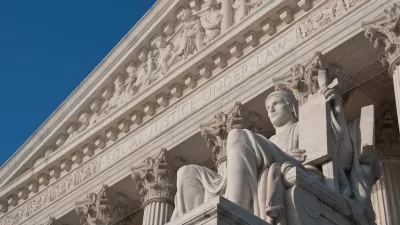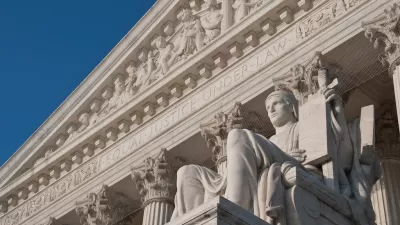The decision in Knick v. Township of Scott prompted a response from the American Planning Association.

A ruling last week from the U.S. Supreme Court in the case Knick v. Township of Scott inspired national news coverage of the ongoing ideological battle on the highest court in the land, also prompting a statement from the American Planning Association that expressed disappointment with the decision.
"The Supreme Court’s liberal and conservative members clashed again Friday [June 21, 2019] on respecting the court’s precedents, this time about when a property owner aggrieved by a local government’s restriction on her land can go to federal court," reports Robert Barnes for The Washington Post.
The 5-4 decision overturned a ruling from 1985 that the "conservative legal establishment" had targeted for reform because it "left property owners without options in federal court if claims in state proceedings are unsatisfactory."
Barnes mostly focuses on the concern among liberal members of the Supreme Court that this case is another example of willingness of the current court to overthrow precedent. Another article by Arianne de Vogue for CNN also focuses on those dynamics of the Supreme Court after the surprise election of Donald Trump.
The American Planning Association picked up on the planning related consequences of the decision, with a statement published online and shared on social media. The state reads, in part:
The American Planning Association (APA) is disappointed with the U.S. Supreme Court’s decision today in Knick v. Township of Scott. The decision upends established precedent for addressing takings challenges and poses potential obstacles for important local land use decisions that benefit communities.
Here's more on the potential consequences of the decision:
The potential for frivolous takings claims to clog federal courts and push local governments into undermining important protections for health, environment, safety, and quality of life for all residents is a real possibility after today’s decision.
A soundbite from John Baker, chair of APA’s Amicus Curiae Committee, is also included in the statement:
“APA urged the Supreme Court to ... decide the case based on existing legal principles, while at the same time clarifying those principles so as to curb their abuses,” said John Baker, chair of APA’s Amicus Curiae Committee. “Instead, by a single vote, the Supreme Court took a meat-ax approach, explicitly overturning a 7-1 decision from 1985 and trivializing language in the Court’s own decisions dating back over 125 years.”
FULL STORY: Supreme Court Overturns Longstanding Property Takings Precedent

Alabama: Trump Terminates Settlements for Black Communities Harmed By Raw Sewage
Trump deemed the landmark civil rights agreement “illegal DEI and environmental justice policy.”

Planetizen Federal Action Tracker
A weekly monitor of how Trump’s orders and actions are impacting planners and planning in America.

The 120 Year Old Tiny Home Villages That Sheltered San Francisco’s Earthquake Refugees
More than a century ago, San Francisco mobilized to house thousands of residents displaced by the 1906 earthquake. Could their strategy offer a model for the present?

In Both Crashes and Crime, Public Transportation is Far Safer than Driving
Contrary to popular assumptions, public transportation has far lower crash and crime rates than automobile travel. For safer communities, improve and encourage transit travel.

Report: Zoning Reforms Should Complement Nashville’s Ambitious Transit Plan
Without reform, restrictive zoning codes will limit the impact of the city’s planned transit expansion and could exclude some of the residents who depend on transit the most.

Judge Orders Release of Frozen IRA, IIJA Funding
The decision is a victory for environmental groups who charged that freezing funds for critical infrastructure and disaster response programs caused “real and irreparable harm” to communities.
Urban Design for Planners 1: Software Tools
This six-course series explores essential urban design concepts using open source software and equips planners with the tools they need to participate fully in the urban design process.
Planning for Universal Design
Learn the tools for implementing Universal Design in planning regulations.
Clanton & Associates, Inc.
Jessamine County Fiscal Court
Institute for Housing and Urban Development Studies (IHS)
City of Grandview
Harvard GSD Executive Education
Toledo-Lucas County Plan Commissions
Salt Lake City
NYU Wagner Graduate School of Public Service





























